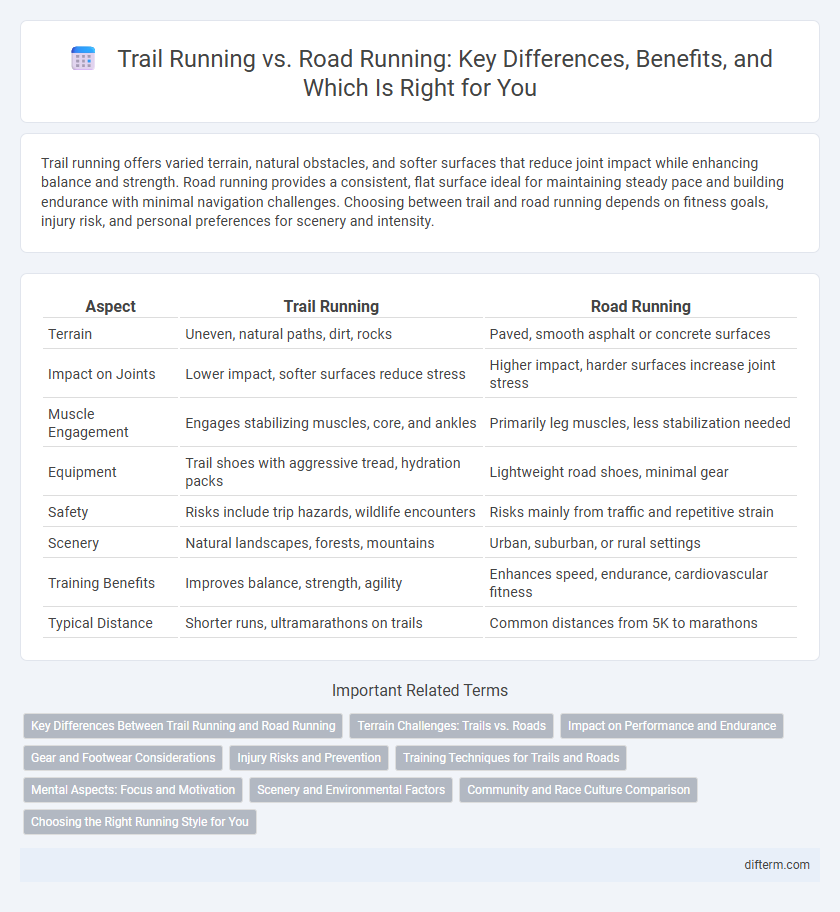Trail running offers varied terrain, natural obstacles, and softer surfaces that reduce joint impact while enhancing balance and strength. Road running provides a consistent, flat surface ideal for maintaining steady pace and building endurance with minimal navigation challenges. Choosing between trail and road running depends on fitness goals, injury risk, and personal preferences for scenery and intensity.
Table of Comparison
| Aspect | Trail Running | Road Running |
|---|---|---|
| Terrain | Uneven, natural paths, dirt, rocks | Paved, smooth asphalt or concrete surfaces |
| Impact on Joints | Lower impact, softer surfaces reduce stress | Higher impact, harder surfaces increase joint stress |
| Muscle Engagement | Engages stabilizing muscles, core, and ankles | Primarily leg muscles, less stabilization needed |
| Equipment | Trail shoes with aggressive tread, hydration packs | Lightweight road shoes, minimal gear |
| Safety | Risks include trip hazards, wildlife encounters | Risks mainly from traffic and repetitive strain |
| Scenery | Natural landscapes, forests, mountains | Urban, suburban, or rural settings |
| Training Benefits | Improves balance, strength, agility | Enhances speed, endurance, cardiovascular fitness |
| Typical Distance | Shorter runs, ultramarathons on trails | Common distances from 5K to marathons |
Key Differences Between Trail Running and Road Running
Trail running involves uneven terrain, natural obstacles, and varied elevation, demanding greater balance and strength compared to road running, which takes place on flat, predictable surfaces like asphalt or concrete. Trail runners benefit from softer ground that reduces joint impact but face challenges like rocks, roots, and mud, whereas road runners experience consistent footing but higher repetitive impact injuries. Equipment also differs significantly, with trail running requiring shoes featuring enhanced grip and protection, while road running shoes prioritize cushioning and responsiveness.
Terrain Challenges: Trails vs. Roads
Trail running presents uneven, rocky, and often steep terrain that demands greater agility, balance, and strength compared to the consistent, flat surfaces of road running. Trail surfaces can vary from mud and roots to loose gravel, increasing the risk of slips and falls, while road running offers predictable footing and reduced injury risk. These terrain challenges influence shoe selection, pacing strategies, and overall running technique, with trail running emphasizing proprioception and adaptability.
Impact on Performance and Endurance
Trail running enhances muscular endurance and joint stability due to varied terrain and elevation changes, promoting improved balance and proprioception. Road running provides consistent surface conditions that facilitate steady pacing and cardiovascular efficiency, optimizing speed and distance endurance. Incorporating both disciplines can lead to well-rounded athletic performance by blending strength, agility, and aerobic capacity.
Gear and Footwear Considerations
Trail running demands specialized footwear with aggressive tread patterns and enhanced ankle support to navigate uneven, rocky terrain and unpredictable conditions. Road running shoes prioritize lightweight design, cushioning, and smooth outsoles for optimal performance on pavements and asphalt. Choosing the right gear, including moisture-wicking apparel and protective accessories, is crucial to maximize comfort and prevent injury in each running environment.
Injury Risks and Prevention
Trail running poses higher injury risks than road running due to uneven terrain, including ankle sprains, falls, and joint strain from unpredictable surfaces. Road running typically causes repetitive stress injuries like shin splints and plantar fasciitis, related to hard, consistent pavement impact. Preventing injuries in trail running requires strength training, proper footwear with ankle support, and cautious pacing, while road runners benefit from gradual mileage increases, cushioned shoes, and balanced stretching routines.
Training Techniques for Trails and Roads
Trail running training emphasizes building ankle stability and proprioception through uneven terrain drills, incorporating hill repeats and technical descents to enhance agility and strength. Road running training focuses on consistent pace work, aerobic endurance, and cadence optimization on flat, predictable surfaces to improve speed and efficiency. Both disciplines benefit from strength training, but trail runners prioritize balance and core stability more to navigate variable trail conditions safely.
Mental Aspects: Focus and Motivation
Trail running demands heightened mental focus due to constantly changing terrain and the need for quick decision-making, fostering improved concentration. Motivation in trail running often stems from the immersive natural environment and personal challenge of navigating unpredictable paths. Road running relies more on sustained rhythmic effort and steady pacing, requiring mental endurance fueled by measurable goals and structured training plans.
Scenery and Environmental Factors
Trail running offers immersive experiences through diverse natural landscapes such as forests, mountains, and rivers, providing varied terrain and fresh air that enhance both physical and mental well-being. Road running typically takes place in urban or suburban environments, featuring predictable flat surfaces and limited natural scenery, which can affect motivation and sensory engagement. Environmental factors like trail elevation changes and uneven paths challenge runners' stability and endurance, contrasting with the smoother, consistent pavement of road running that favors speed and rhythm.
Community and Race Culture Comparison
Trail running fosters a close-knit community centered on environmental appreciation and mutual support, often featuring small, intimate races in natural settings. Road running communities tend to be larger and more competitive, with organized events ranging from local 5Ks to international marathons attracting diverse participants. The race culture in trail running emphasizes adventure and endurance, while road running focuses on speed benchmarks and personal records.
Choosing the Right Running Style for You
Trail running offers uneven terrain and natural obstacles that enhance strength and balance, while road running provides a consistent surface ideal for speed and endurance training. Consider your fitness goals: trail running improves agility and engages stabilizing muscles, whereas road running benefits cardiovascular performance and pace tracking. Assess local access, injury risk, and personal preference to select the running style that maximizes enjoyment and physical development.
trail running vs road running Infographic

 difterm.com
difterm.com